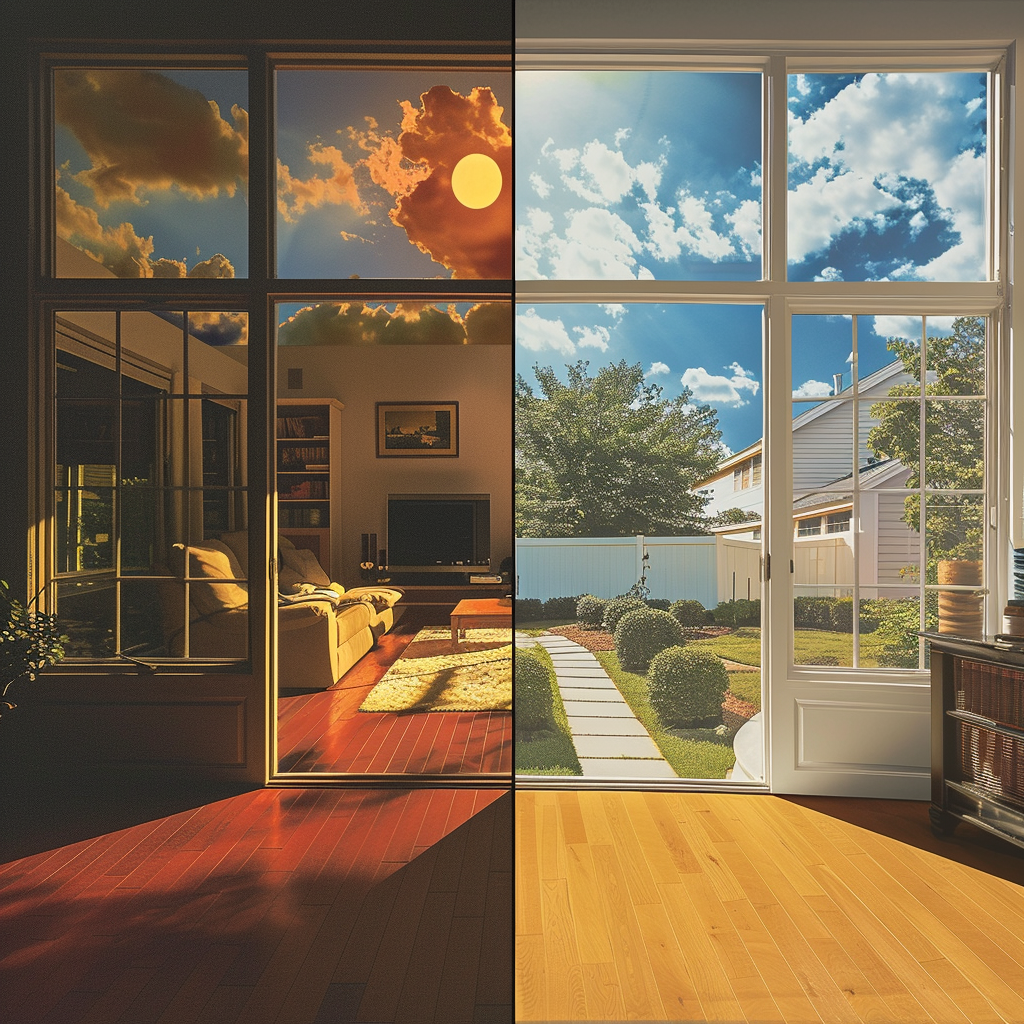
Window tinting can slash your energy bills by minimizing heat entry and reflecting sunlight away, which decreases your air conditioning use and interior heat gain. It enhances home comfort by reducing glare and protecting your furniture from fading. It offers a cooling effect akin to having an air conditioner on but at a fraction of the cost. By investing in professional window film, you’re opting for sustainability and improved home comfort through reduced energy consumption. Each type of window film, metalized, ceramic, or dyed, provides unique UV protection, heat reduction, and aesthetic benefits. The correct selection and proper installation are essential for maximizing these energy efficiency benefits. Understanding the various types of window films and their installation intricacies can lead to significant savings, sustainability, and an eco-friendlier lifestyle, with further insights available for those interested in exploring this effective energy-saving measure.
Understanding Energy Savings
Although window tinting may seem like a small change, it can greatly reduce your energy bills by reducing the heat entering your building during the summer. By applying window film, you’re not just enhancing your space’s aesthetic appeal but also beginning a journey toward significant energy savings. This innovative solution works by reflecting sunlight away from your building, diminishing the interior heat gain that could lead to excessive air conditioning use. In doing so, window film helps in lowering your energy costs substantially.
Moreover, window film contributes to home comfort by reducing glare and preventing the fading of furniture without compromising the natural light that brightens your home. It’s a balanced approach to maintaining an inviting and comfortable interior environment. Installing professional window film, especially designed for energy efficiency, can be a game-changer. Not only does it offer a cooling effect equivalent to that of air conditioning units, but it also makes your space more energy-efficient all year round. By investing in window film, you’re not just cutting down on your energy bills but also taking a step towards sustainability and improved home comfort.
Types of Window Film
When selecting window film, it’s vital to understand the distinctions between metalized, ceramic, dyed, and hybrid types. Each provides unique advantages in terms of UV protection, heat reduction, and visibility. Metalized films use tiny metallic particles to reflect UV light and heat, greatly reducing glare and interior heat gain. This reflection mechanism is essential in keeping your space cooler, directly contributing to energy savings by reducing the burden on your cooling system.
Ceramic window films stand out for their exceptional durability and ability to absorb heat without compromising visibility. Unlike metalized films, they don’t contain metal, so they won’t interfere with electronic devices and offer a clearer view. This makes them an ideal choice for those prioritizing clarity alongside energy efficiency.
Dyed and hybrid films combine features of the first two, offering a balance between aesthetics, UV protection, and heat reduction. While dyed films primarily absorb solar energy, reducing heat transfer into your space, hybrid films incorporate dye and metallic components, offering a middle ground in performance and cost.
Selecting the right solar control film can significantly impact your ability to save money on energy bills while protecting your space from harmful UV rays. Each type offers unique benefits, so it’s essential to take into account your specific needs and preferences during the selection process.
Installation Process
Proper window tinting installation is essential for achieving maximum energy savings and ensuring the film’s long-term effectiveness. When you opt for professional window tinting, you’re not just enhancing the aesthetics of your space; you’re investing in a solution that greatly reduces energy costs. The process begins with selecting the correct window film tailored to your specific needs, focusing on maximizing energy efficiency.
The technical expertise involved in window film installation cannot be overstated. Professionals meticulously clean the window surface to ensure no debris interferes with the film’s adherence. Precision in cutting and applying the film is important to avoid common issues like bubbling and peeling, which can detract from both the film’s appearance and insulating properties. Remember, an incorrectly installed film can reduce effectiveness, undermining the potential energy savings.
Calculating Cost Benefits
To accurately gauge the financial advantages of window tinting, you’ll need to consider various factors, including the dimensions of your windows, the type of film used, and the prevailing local energy rates. Calculating cost benefits involves a detailed analysis to understand how window films can effectively reduce your energy bills and save money in the long term.
For commercial buildings, the savings on energy bills can be significant. By reducing the heat entering the building, there’s less reliance on air conditioning, directly lowering energy consumption and costs. The type of window film plays an important role; some films are more efficient than others in blocking solar heat. Additionally, the size of your windows will determine the heat entering your building, affecting the potential savings.
Local energy rates also influence the cost benefits of window tinting. Areas with higher energy costs will see more significant savings. On average, businesses can expect to save between 5% to 15% annually on their energy bills, with the installation cost potentially paying for itself in just a few years. Remember, up to 10% of the installation cost might be reclaimed through tax credits, enhancing the financial benefits further.
Environmental Impact
Window tinting greatly reduces energy consumption, directly translating into a substantial decrease in greenhouse gas emissions and fostering a more sustainable environment. By installing window tinting, you’re cutting down your energy bills and contributing greatly to a larger cause—reducing the carbon footprint. This action is a step towards mitigating climate change and promoting healthier ecosystems.
The environmental impact of window tinting is profound. Decreasing the need for air conditioning reduces the demand for electricity, especially during peak hours. This reduction in energy use is vital, as it lessens the strain on the power grid and negates the necessity for new power plants, often powered by fossil fuels. Through this, window tinting plays a pivotal role in energy conservation efforts, making it an indispensable tool in the fight against global warming.
Moreover, you’re advocating for a sustainable lifestyle by embracing window tinting. It demonstrates your commitment to preserving natural resources and fostering an eco-friendly community. Essentially, window tinting doesn’t just save you money; it serves a greater good, paving the way for a more sustainable and environmentally conscious society.
Maintenance Tips
Having understood the significant environmental benefits of window tinting, it’s equally important to focus on maintaining your tinted windows to guarantee they continue to offer the best energy savings. Regular maintenance is key to preserving the efficacy of your window film. Start by routinely cleaning the tinted surfaces with a mild, non-abrasive cleaner. This simple step guarantees that the window film effectively blocks solar heat, maintaining your home’s energy efficiency.
Inspect your window film periodically for signs of damage or peeling. Early detection and prompt repair are essential for damage prevention and to avoid potential energy loss. Remember, even minor damage can significantly impact the window film’s energy-saving capabilities.
Professional installation plays a pivotal role in the longevity and effectiveness of window tint. Trained professionals ensure that the film is applied correctly, maximizing energy savings and extending the lifespan of your window tint. Additionally, use caution around your tinted windows. Sharp objects can easily damage the film, compromising its energy efficiency.
Consider reapplying window film every 10-15 years to uphold the best energy-saving benefits. This maintenance strategy ensures your window tint contributes significantly to energy savings, aligning with your goal of serving others by optimizing energy use and reducing environmental impact.
Professional Advice
Seeking professional advice is essential when selecting the best window tinting solution to maximize your energy savings. Professionals in window tinting can offer insights into the most efficient window film options tailored to your specific needs, guaranteeing you save money and achieve maximum energy savings. They understand how different films can impact your home’s energy efficiency and can recommend options that offer the best return on investment.
Consulting with a professional doesn’t just help you choose the right product; it also secures professional installation. This is pivotal because:
- Improperly installed window film can lead to air bubbles and peeling, diminishing its effectiveness and lifespan.
- Professional installation ensures that the window film adheres correctly to the glass, optimizing its energy-saving capabilities.
- Experts can verify that the window tint complies with local regulations and warranty requirements, safeguarding your investment.
Ultimately, investing in professional advice and installation can significantly influence your ability to save money on energy bills. By leveraging their expertise, you can guarantee that your window tinting enhances your home’s energy efficiency and contributes to long-term cost savings and comfort.
Conclusion
To sum up, transitioning to window tinting is a wise energy-saving choice. Surprisingly, some homeowners report up to a 30% reduction in cooling costs after installation. This significant saving and the environmental benefits of reduced energy consumption make window tinting an efficient and cost-effective solution. Remember, proper maintenance and consulting with professionals can maximize these benefits. Embrace window tinting to save money and contribute to a greener planet.






Comments are closed.